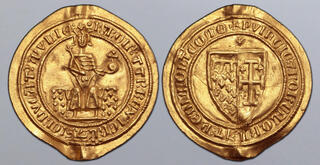| Roma Numismatics Ltd. > E-Sale 119 | Auction date: 24 April 2024 |
| Lot number: 2981 Price realized: 7,500 GBP (Approx. 9,325 USD / 8,724 EUR) Note: Prices do not include buyer's fees. | Show similar lots on CoinArchives Find similar lots in upcoming auctions on |
| Lot description: Italian States, Kingdom of Naples and Sicily. Carlo d'Angiò AV Seal. Struck as king of Jerusalem and Sicily, duke of Apulia, count of Provence, Achaea, Forcalquer and Piamonte (1277-1285). ❀ KAROL' : TTI'. RЄX : IЄRL : Ƶ : SICI : DVCAT'. APVLIЄ :, Charles enthroned holding cross on globe and sceptre / ✠ PVIꞂCIЄ : Ƶ : FORCALQUR... AT : PЄDIMONT'. COᙏЄ, Arms of France and Jerusalem. Unpublished in the standard references; I. Vecchi, Un sigillo d'oro inedito di Carlo d'Angiò, Monete Antiche no. 104, Marcc-April, 2019, p.44; for another gold seal, cf. P. Sella, Inventari dell'archivio segreto Vaticano: Le bolle d'oro, Vaticano 1934, 10 = A. Martini, I sigilli d'oro - The gold seals of the Vatican Secret Archives, Milano 1984, 11a-b. 17.19g, 49mm, 12h. Extremely Fine. Unique and of considerable historic significance. This seal published in 'Un sigillo d'oro inedito di Carlo d'Angiò' in Monete Antiche no. 104 (2019). Charles of Anjou, founder of the Angevin dynasty in Naples, was the youngest son of Louis VIII and brother of King Louis IX of France. He took part in Louis IX's crusades to Egypt in 1248 and Tunisia in 1270. After obtaining Provence by marriage in 1246, which extended his influence into Piedmont, he became senator of Rome (1263, 1265–78) and undertook to champion the papal cause against Manfred, the Hohenstaufen who had usurped the Kingdom of Naples and Sicily in 1258. In reward, he was crowned king of Naples and Sicily in 1266 by Pope Clement IV, which he had already received as a papal grant in 1262. Charles defeated and killed Manfred at the Battle of Benevento in 1266 and then defeated and executed the last of the Hohenstaufen line, Conradin, later that year. As leader of the Guelphs, or papal faction, he gained political hegemony in Italy and won suzerainty over several cities in Tuscany, Piedmont, and Lombardy, but his overbearing policies led to a cooling of his relations with the papacy. Planning to establish his own empire, he allied himself with the deposed Latin ruler of Constantinople, Baldwin II, against Greek Michael VIII and fought for years in the Balkans. Corfu, Epirus, and Albania were taken. On 18 March 1277, he bought the claim and assumed the title of King of Jerusalem, sending Roger of San Severino as his bailli to Acre. There Roger ousted Balian of Arsuf (Balian of Ibelin), the bailli of Hugh III, and compelled the nobles to swear fealty. In the meantime, Gregory had been succeeded by Pope Innocent V, who arranged a peace between Charles and the Genoese. The crushing taxes necessitated by his wars and his appointment of oppressive French officials to exact them led to the Sicilian Vespers in 1282. The ensuing war against the Sicilian rebels and Peter III of Aragón, chosen by the rebels as king of Sicily, continued after his death in Foggia in 1285 under Charles's son and successor, Charles II, then a prisoner in Catalonia, so the regency passed to his French cousin Robert II of Artois, son of the younger brother of St Louis. A similar gold seal of Charles of Anjou is held by the Bibliothèque nationale de France in Paris. The legend (✠ • KAROLVS • DЄI • GRACIA • SICILIЄ • RЄX • / ✠ OVCATVS • APVLIЄ PRICIPAT' CAPVЄ) suggests the Paris example was struck before Charles purchased the claim to the Kingdom of Jerusalem in 1277, as does the coat-of-arms which was updated thereafter (see reverse of this lot). Despite this, the same frontal, enthroned depiction of the King holding a globus cruciger and sceptre was struck on both seals to identify them with Charles. The style of the epigraphy is similarly consistent on both examples, as is the understated 13th century style of engraving. Estimate: 5000 GBP |  |


